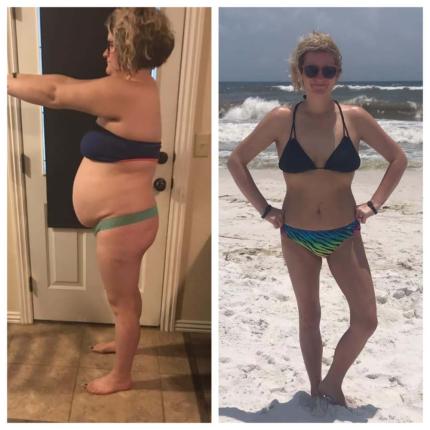Before & After Gastric Balloon, Obesity Travel Turkey
Calculate Your Cost / Price
-
2.1 Who is Suitable for a Gastric Balloon?
The gastric balloon is suitable for adults with a body mass index (BMI) of 30-40 who have not succeeded with other weight loss methods. It is also considered for individuals with a BMI over 27 who have obesity-related health conditions such as diabetes, hypertension, or sleep apnea.
-
2.2 Who is Not Suitable for a Gastric Balloon?
The gastric balloon is not suitable for individuals with certain medical conditions, including those with a history of gastrointestinal surgery, severe liver disease, or inflammatory bowel disease. It is also not recommended for pregnant women or those planning to become pregnant soon.
-
3 Risks and Complications of the Gastric Balloon in Turkey
While the gastric balloon is generally safe, there are potential risks and complications associated with its use. These can include nausea, vomiting, abdominal pain, and acid reflux, especially in the first few days after insertion. More serious complications, although rare, can include balloon deflation and migration, leading to intestinal obstruction.
-
3.1 What Happens if the Gastric Balloon Burst in Turkeys?
If a gastric balloon deflates or bursts, it can potentially migrate into the intestines, causing an obstruction. In such cases, immediate medical attention is required to remove the deflated balloon. Most modern gastric balloons are designed with a safety feature that changes the color of the patient’s urine if the balloon deflates, providing an early warning sign.
-
4 What are the Outcomes of Gastric Balloon Application?
The primary outcome of gastric balloon application is significant weight loss. Patients can expect to lose between 10-15% of their total body weight over the six months the balloon is in place. This weight loss can lead to improvements in obesity-related conditions such as type 2 diabetes, hypertension, and sleep apnea. Additionally, patients often experience an enhanced quality of life and increased mobility.
-
5 After the Gastric Balloon
Post-procedure care is crucial for the success of the gastric balloon treatment. This includes dietary modifications, regular physical activity, and psychological support to ensure long-term weight management.
-
5.1 Nutrition After the Gastric Balloon
After the gastric balloon insertion, patients must follow a liquid diet for the first few days, gradually progressing to soft foods and then regular foods. A nutritionist often guides patients in adopting a balanced, low-calorie diet to maximize weight loss and maintain results after the balloon is removed.
-
5.2 Physical Activity Orientation
Regular physical activity is essential after gastric balloon placement. Patients are encouraged to engage in moderate exercise, such as walking, swimming, or cycling, to enhance weight loss and overall health. An exercise plan tailored to the patient's abilities and goals can help maintain motivation and consistency.
-
5.3 Psychological Support
Psychological support plays a vital role in the success of the gastric balloon procedure. Counseling or support groups can help patients address emotional eating habits, stay motivated, and cope with the lifestyle changes required for sustained weight loss.
6 Frequently Asked Questions About the Gastric Balloon Procedure
-
6.1 How Does the Gastric Balloon Help with Weight Loss?
The gastric balloon helps with weight loss by taking up space in the stomach, which reduces the amount of food the stomach can hold and promotes a feeling of fullness. This helps patients eat smaller portions and reduce their overall calorie intake.
-
6.2 What is the Purpose of the Gastric Balloon?
The purpose of the gastric balloon is to provide a non-surgical, temporary weight loss solution for obese individuals. It helps jumpstart weight loss, providing patients with the motivation and physical changes needed to adopt healthier lifestyle habits.
-
6.3 Are People Satisfied with the Gastric Balloon?
Many patients report high satisfaction with the gastric balloon due to the significant weight loss achieved and improvements in obesity-related health conditions. However, success depends on the patient's commitment to lifestyle changes and follow-up care.
-
6.4 What are the Advantages of the Gastric Balloon?
Advantages of the gastric balloon include its non-surgical nature, relatively quick and easy insertion and removal procedures, and significant weight loss potential. It also provides an option for patients who are not candidates for or do not wish to undergo bariatric surgery.
-
6.5 What are the Risks / Disadvantages of the Gastric Balloon?
The risks and disadvantages of the gastric balloon include potential side effects such as nausea, vomiting, and abdominal discomfort, especially in the initial days. There is also a risk of balloon deflation and migration. Additionally, the weight loss achieved can vary, and maintaining the results requires a strong commitment to lifestyle changes.
6.6 How Much Weight Can I Lose with the Balloon?
Patients can expect to lose between 10-15% of their total body weight over the six months the balloon is in place. The exact amount of weight loss depends on factors such as adherence to dietary recommendations and engagement in physical activity.
Gastric Sleeve Turkey, Mini Gastric Bypass Turkey, Gastric Bypass Turkey, Gastric Balloon Turkey, Scarless Gastric Sleeve Surgery Turkey, Gastric Surgery Turkey, Gastric Sleeve Antalya, Mini Gastric Bypass Antalya, Gastric Bypass Antalya, Gastric Balloon Antalya, Scarless Gastric Sleeve Surgery Antalya, Gastric Surgery Antalya, Gastric Sleeve in Antalya, Gastric Sleeve Price Antalya, Allurion Swallowable Gastric Balloon in Antalya, Gastric Sleeve in Turkey, Gastric Sleeve Price Turkey, Mini Gastric Bypass in Antalya, Mini Gastric Bypass in Turkey, Gastric Balloon Treatment Antalya, Gastric Balloon Treatment Turkey, Gastric Balloon Procedure All Inclusive in Turkey, Aesthetic Travel Antalya, Gastric Sleeve Travel Antalya, Gastric Balloon Travel Antalya, Gastric Bypass Travel Antalya, Aesthetic Travel Turkey, Gastric Sleeve Travel Turkey, Gastric Balloon Travel Turkey, Gastric Bypass Travel Turkey, Gastric Balloon in Antalya, Gastric Balloon in Turkey, Obesity Travel Antalya, Obesity Travel Turkey
FQ About Gastric Balloon Clinic in Antalya / Turkey
The primary difference between mini gastric bypass surgery and a full gastric bypass is that the mini version of the surgery is performed in a modified manner that involves less intestinal rerouting and a shorter overall surgery time. After surgery, you should avoid nonsteroidal anti-inflammatory drugs (NSAIDs), such as aspirin, ibuprofen (Motrin, Advil) and naproxen (Aleve). NSAIDs increase the risk of stomach ulcers. Patients who had gastric bypass surgery should avoid these medications indefinitely. Bread, Rice... +More
The "Skinny Pen" refers to a weight-loss medication called liraglutide (brand name Saxenda) that is administered through a daily injection. It works by mimicking a hormone that regulates appetite, helping patients feel fuller for longer. This treatment is often used for individuals who struggle with obesity but are not candidates for surgery or who need additional help in managing their weight post-bariatric surgery. The drug is available by prescription and is used in conjunction with diet and exercise.
The diet after sleeve gastrectomy is crucial for recovery and long-term success. Patients start with a liquid diet, then gradually progress to pureed foods, soft foods, and eventually solid meals over several weeks. A focus on high-protein, low-carbohydrate, and nutrient-dense foods helps maintain weight loss and avoid deficiencies. Hydration and vitamin supplementation are also important aspects of the post-sleeve diet.
Roux-en-Y bypass is another term for the RNY procedure. This surgery helps patients lose weight by creating a small pouch from the stomach and connecting it directly to the small intestine, bypassing a portion of the digestive tract. The result is a reduced ability to absorb calories and nutrients. Patients who undergo RNY experience rapid weight loss, but it also requires them to make permanent changes to their diet and lifestyle to avoid complications like dumping syndrome, where food moves too quickly from the... +More
Australian patients who have undergone gastric sleeve surgery often share their experiences online, both positive and negative. The reviews highlight the importance of choosing the right surgeon and following a proper post-surgery diet and exercise regimen. Many patients in Australia choose to travel overseas for more affordable surgery options in countries like Turkey. These reviews also discuss the emotional and psychological challenges that come with dramatic weight loss.
Gastric sleeve results are typically impressive, with patients losing 50-60% of their excess body weight within the first year. The surgery also leads to improvements in obesity-related conditions like diabetes, hypertension, and sleep apnea. Long-term success depends on the patients ability to maintain a healthy lifestyle post-surgery.
Sleeve gastrectomy is a common type of bariatric surgery where approximately 75-80% of the stomach is removed, leaving a smaller, tube-like stomach or "sleeve." This surgery is irreversible and promotes weight loss by limiting the amount of food the stomach can hold and reducing the production of ghrelin, the hormone responsible for hunger. The procedure has gained significant popularity in Antalya due to its lower cost, experienced surgeons, and advanced medical facilities.
Gastric sleeve surgery in Turkey is one of the most popular weight loss surgery treatments. This bariatric surgery treatment is popular as it is one of the more effective treatments for weight loss.
The stomach sleeve diet follows the same principles as the gastric sleeve diet. After the surgery, patients must follow a structured eating plan, starting with liquids and progressing to solid foods over several weeks. The diet focuses on small, high-protein meals to support weight loss and ensure adequate nutrition.
Istanbul is the medical hub of Turkey, attracting thousands of patients annually for bariatric surgery. Many top clinics and hospitals specializing in gastric sleeve surgery are located in this city, offering world-class services and facilities. Istanbuls geographic location makes it easily accessible for patients traveling from Europe, the Middle East, and North Africa. The city offers a unique blend of cultural tourism and medical care, making it an ideal destination for those seeking both medical treatment and... +More
Abdominal cancer refers to any malignant tumor in the abdomen, including stomach, liver, pancreatic, or colon cancer. Symptoms vary but may include unexplained weight loss, abdominal pain, and changes in bowel habits. Early detection is crucial for successful treatment, which may involve surgery, chemotherapy, or radiation.
Pages
-
£ 1580£ 1450GASTRIC BALLOON PROCEDURE PACKAGE
Give a call to learn more about what’s included and to come up with a tailored plan if you need unique accommodations that are not listed below.
- Airport
- Hotel
- Hospital transfer
- The balloon is placed via endoscopy, the procedure takes 15-20 minutes and you are discharged after 2-3 hours. It is enough to stay here for 1 night.
- Blood samples & x-rays
- 5 year follow up
-
£ 2750£ 2550GASTRIC SLEEVE PACKAGE
GASTRIC SLEEVE PACKAGE COST TURKEY / ANTALYA
Give a call to learn more about what’s included and to come up with a tailored plan if you need unique accommodations that are not listed below.- Airport
- Hotel
- Hospital transfer
- 4 day stay at hospital
- Blood samples & x-rays
- 5 year follow up
-
£ 3100£ 2900MINI GASTRIC BYPASS PACKAGE
MINI GASTRIC BYPASS PACKAGE TURKEY
Give a call to learn more about what’s included and to come up with a tailored plan if you need unique accommodations that are not listed below.- Airport
- Hotel
- Hospital transfer
- 4 day stay at hospital
- Blood samples & x-rays
- 5 year follow up













